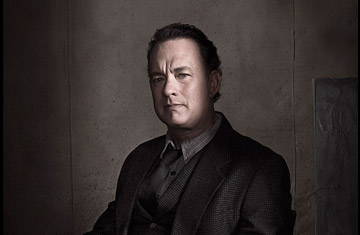
(3 of 7)
What Hanks absorbed from those caffeinated reading bouts informs The Pacific, which starts with the aftermath of Pearl Harbor and moves straight into the murderous Guadalcanal campaign (August 1942 to February 1943), depicting the harrowing details right down to the dysentery and malaria. Cameras zoom down vulture-like on maps of flyspeck islands; the contrivance provides a nautical atlas for globe-challenged viewers. The true-life stories of Colonel Lewis "Chesty" Puller and Gunnery Sergeant John Basilone are incorporated into the narrative's bloodstream. Eight of its 10 hours rain valor worthy of a Medal of Honor. (If the roughly two hours of romantic sequences of Marines falling head over heels in love seem hokey by comparison, chalk it up to the demands of serial entertainment.) Nearly every prop used in the miniseries is an exact replica. "Steven [Spielberg] and I wanted to provide people with an accurate visual sense of time and geography," Hanks says.
In Saving Private Ryan, Spielberg had vividly captured ghostly, pockmarked European ruins in elegantly warped shades of brown, grey and beige. Those drab colors wouldn't do for a miniseries set in the blindingly blue Pacific Basin. Together, Spielberg and Hanks did tests at a Universal Studios back lot to conjure up a faded Hawaiian postcard look. Palm fronds, ripe coconuts and white clouds pop out from the TV screen in a tamped-down Day-Glo way. The cinematic effect is mesmerizing.
Public education was an integral component of Hanks' vision. "We wanted to explain the arc of the Pacific war, the motivation within from the strategic perspective," he says. "So we start with the vast Pacific Ocean from Hawaii, and you just keep going farther and farther west. You get a dramatic sense of what it must have been like to be on one of those battleships. I used to wonder why in hell little Peleliu was in any way, shape or form so damn important. But then when you see how close Okinawa is, well, you immediately understand. Peleliu was a stepping-stone."
Much of the miniseries is based on two evocative World War II memoirs, Eugene Sledge's With the Old Breed and Robert Leckie's Helmet for My Pillow, but the imaginative energy comes straight from novels like Norman Mailer's The Naked and the Dead and James Jones' The Thin Red Line. The result is like Herman Wouk's The Winds of War (both the novel and the made-for-TV movie) on steroids. Hanks and fellow executive producers Spielberg and Gary Goetzman are wrestling with age-old--and current--questions about the barbarity of war: How can Americans ask our young men and women to indiscriminately kill a shadowy enemy and then return to their ordered Coca-Cola lives Stateside?
"It's even worse for our troops fighting in Iraq and Afghanistan," Hanks says. "At least the Pacific-war soldiers coming back from World War II decompressed on ships for weeks. And then once the troops arrived portside, it was often a long train ride home to Peoria. Today these guys in Afghanistan fight in bloody hell and are flown back in 18 hours. How can they cope with that? How can they suddenly go from Tora Bora to Peyton Place?" Even the legendary Audie Murphy, the most decorated soldier in World War II, suffered posttraumatic stress disorder after his return from the European theater. During one meltdown, a deranged Murphy held his wife hostage at gunpoint.
